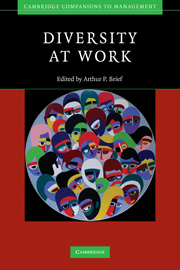Book contents
- Frontmatter
- Contents
- List of figures
- List of tables
- List of contributors
- Foreword
- Preface
- 1 Introduction: Where the sweet spot is: Studying diversity in organizations
- Part I Conceptual foundations
- 2 Stereotypes and prejudice create workplace discrimination
- 3 Promoting racial diversity at work: Challenges and solutions
- Part II Emerging theoretical approaches
- Part III Moving ahead: Agendas for practice and research
- Index
- References
2 - Stereotypes and prejudice create workplace discrimination
Published online by Cambridge University Press: 19 May 2010
- Frontmatter
- Contents
- List of figures
- List of tables
- List of contributors
- Foreword
- Preface
- 1 Introduction: Where the sweet spot is: Studying diversity in organizations
- Part I Conceptual foundations
- 2 Stereotypes and prejudice create workplace discrimination
- 3 Promoting racial diversity at work: Challenges and solutions
- Part II Emerging theoretical approaches
- Part III Moving ahead: Agendas for practice and research
- Index
- References
Summary
John Williams is a black American. On his first day of work at a new job at a mid-size print advertising firm, he arrived early to set up his office, only to find that his “office” was not with the other two new recruits but in the basement, in what was previously a janitor's closet. Displayed prominently on his computer was a noose.
Kevin Nakamoto is a Japanese-American, entry-level market analyst who recently transferred to another office. In deciding where to eat for lunch, one of his new co-workers asked if Kevin would mind if they did not have Chinese food. Later that day, another co-worker came by to introduce herself. As they chatted, she assumed that Kevin would be helpful in computer consulting and she volunteered that no one would mind if he was a social loner.
Mary Carpenter is a white, 22-year-old interested in construction. For the past six months, she has been unsuccessfully searching for a job. Though she has submitted applications to all jobs for which she felt qualified, she has had no luck. In the same time period, she saw her male friends receive offers in the same field, so she knows the demand is definitely there.
McKenzie Wilkes is a married, mother-of-two, successful attorney at a large firm. She is one of the most feared litigators in the courtroom and one of the most referred among her clients. Despite her impressive resumé, she was turned down as a partner at the firm.
- Type
- Chapter
- Information
- Diversity at Work , pp. 13 - 52Publisher: Cambridge University PressPrint publication year: 2008
References
- 37
- Cited by



